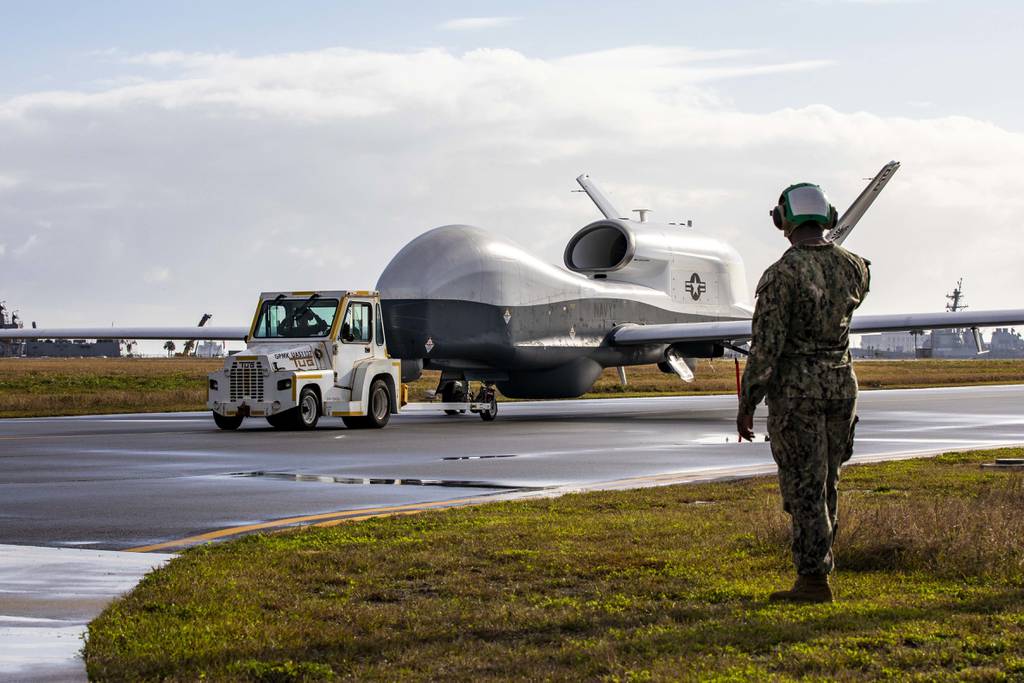
SAN DIEGO — A Northrop Grumman unmanned aircraft system is indispensable to the U.S. Navy’s future ability to monitor actions around the world, share insights about them and respond accordingly, a service leader said.
The autonomous MQ-4C Triton intelligence, surveillance, reconnaissance and targeting drone can fly for more than 24 hours at a time and at altitudes greater than 10 miles, with a range of more than 8,000 nautical miles. Sensors aboard can cue onto electronic signals and adversary communications, and that information can be relayed to warships and other aircraft.
Vice Adm. Craig Clapperton, the Navy’s leader of Fleet Cyber Command, told attendees at the West conference in San Diego the Triton’s signals and geospatial intelligence capabilities are of particular interest to him and his teams. The drone achieved initial operating capability last year, following use in the Indo-Pacific.
Clapperton expects improved information-sharing across the service as Triton usage continues. Northrop has delivered at least five of the uncrewed systems to the service.
“If Triton is on an INDOPACOM orbit, it doesn’t just communicate with Naval Information Operations Command Pacific in Hawaii,” he said. “They’re communicating with Whidbey Island, they’re communicating with Task Force 1060 in NIOC Maryland. They’re communicating with Task Force 1050.”
Northrop last year said it was able to shuttle information between its Triton and simulated battlefield assets, including an F-35, an E-2D Advanced Hawkeye, destroyers and carrier strike groups. The connectivity was made possible via a “gateway” that hooked into the drone’s onboard radar and advanced computing.
To stay ahead of China and Russia, the U.S. military is attempting to dissolve the membranes that have long compartmentalized the services, their databases and their weapons. The multibillion-dollar push, referred to as Combined Joint All-Domain Command and Control, envisions any sensor feeding any shooter the data he or she needs — meaning responses to foreign aggression will likely be quicker, more efficient and less constrained by geography.
“Around the globe, as these Tritons expand their orbit, they will be communicating with all of my NIOCs and bringing, really, a federated approach to that battlespace awareness and how we can help the warfighter have a better understanding of what’s going on in their area of responsibility,” Clapperton said.
Colin Demarest is a reporter at C4ISRNET, where he covers military networks, cyber and IT. Colin previously covered the Department of Energy and its National Nuclear Security Administration — namely Cold War cleanup and nuclear weapons development — for a daily newspaper in South Carolina. Colin is also an award-winning photographer.
- SEO Powered Content & PR Distribution. Get Amplified Today.
- PlatoData.Network Vertical Generative Ai. Empower Yourself. Access Here.
- PlatoAiStream. Web3 Intelligence. Knowledge Amplified. Access Here.
- PlatoESG. Carbon, CleanTech, Energy, Environment, Solar, Waste Management. Access Here.
- PlatoHealth. Biotech and Clinical Trials Intelligence. Access Here.
- Source: https://www.defensenews.com/unmanned/uas/2024/02/13/airborne-triton-drone-key-to-navys-signal-goals-clapperton-says/



